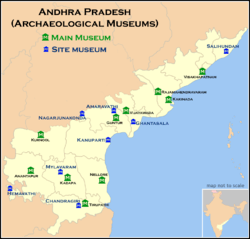Chandragiri
| Chandragiri | |
|---|---|
| Fort, Town | |
|
Raja Mahal, Chandragiri | |
 Chandragiri Location in Andhra Pradesh, India  Chandragiri Chandragiri (India) | |
| Coordinates: 13°35′00″N 79°19′00″E / 13.5833°N 79.3167°ECoordinates: 13°35′00″N 79°19′00″E / 13.5833°N 79.3167°E | |
| Country | India |
| State | Andhra Pradesh |
| Mandal | Chandragiri |
| Government | |
| • Member of Legislative Assembly | CheviReddy Bhaskar Reddy |
| Area[1] | |
| • Total | 19.56 km2 (7.55 sq mi) |
| Population (2011)[1] | |
| • Total | 20,299 |
| • Density | 1,000/km2 (2,700/sq mi) |
| Languages | |
| • Official | Telugu |
| Time zone | UTC+5:30 (IST) |
| PIN | 517101 |
| Telephone code | +91–877 |


Chandragiri is a village in Chittoor district of the Indian state of Andhra Pradesh. It is the mandal headquarters of Chandragiri mandal in Tirupati revenue division.[1][2] It also falls in the jurisdictional limit of Tirupati Urban Development Authority.[3]
History
Chandragiri fort
Chandragiri is now famous for the historical fort, built in the 11th century, and the Raja Mahal (Palace) within it. The fort encircles eight ruined temples of Saivite and Vaishnavite pantheons, Raja Mahal, Rani Mahal and other ruined structures.
The Raja Mahal Palace is now an archaeological museum. The fort and palace are in the care of the Archaeological Survey of India. The palace is open to the public, but the fort is closed. The palace is an example of Indo-Sarcen architecture of the Vijayanagar period. The palace was constructed using stone, brick, lime mortar and devoid of timber.[4] The crowning towers represents the Hindu architectural elements.
Chandragiri was under the rule of Vijayanagar from 1367. It came into prominence during Saluva Narasimha Rayalu. Chandragiri was the 4th capital of Vijayanagar Empire. Rayas shifted their capital to here when Golconda sultans attacked Penukonda. In 1646, the fort was annexed to the Golkonda territory.
The Mysore king ordered the Palaygara (feudatory ruler) Bisaya nayaka who took aid from Mysore Kingdom after decline of Vijayanagara Empire. Bisaya nayaka of Harapanayakanahalli, present Mulbagal (T) Kolar (D) of Karnataka, Waged a war against the sultan of Chandragiri fort in which he and his army killed every one inside the fort who revolted. (there is myth that only the nose rings collected from dead Muslim women were 3 full bamboo bucket, which is sealed in 2 stone locker in Kurudumale Village, Karnataka) Later after the death of sulthan it subsequently came under Mysore rule. It went into oblivion from 1792 onward.[4]
References
| Wikimedia Commons has media related to Chandragiri. |
- 1 2 3 "District Census Handbook - Chittoor" (PDF). Census of India. p. 19,280. Retrieved 29 November 2015.
- ↑ "Chittoor District Mandals" (PDF). Census of India. pp. 460, 512. Retrieved 19 June 2015.
- ↑ "TUDA Right to Information Act, 2005". TUDA. Retrieved 19 June 2015.
- 1 2 Archaeological Survey of India (2008). "Raja and Rani Mahal, Chandragiri Fort; Ticketed Monuments - Andhra Pradesh". Archaeological Survey of India. Archived from the original (asp) on 2008-09-30. Retrieved 2008-09-30.